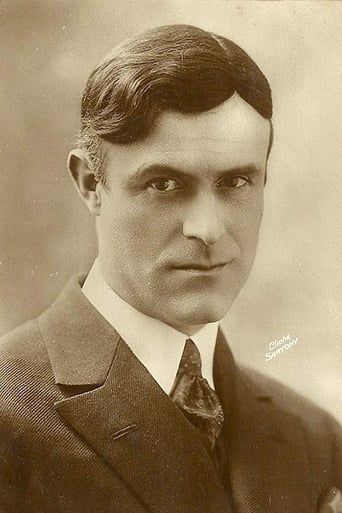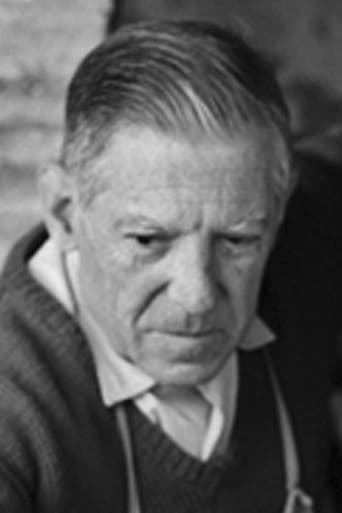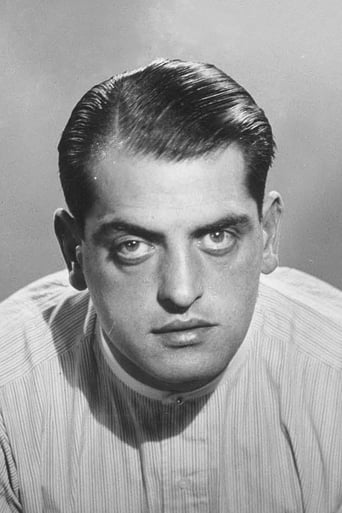Forumrxes
Yo, there's no way for me to review this film without saying, take your *insert ethnicity + "ass" here* to see this film,like now. You have to see it in order to know what you're really messing with.
FirstWitch
A movie that not only functions as a solid scarefest but a razor-sharp satire.
Matho
The biggest problem with this movie is it’s a little better than you think it might be, which somehow makes it worse. As in, it takes itself a bit too seriously, which makes most of the movie feel kind of dull.
Caryl
It is a whirlwind of delight --- attractive actors, stunning couture, spectacular sets and outrageous parties. It's a feast for the eyes. But what really makes this dramedy work is the acting.
oOoBarracuda
How free are human beings when every aspect of our being is decided by forces beyond our control? L'Age d'Or explores the notion of the damage caused by the human spirit that must submit to the shackled world society's, religion's, and family's expectations. Luis Buñuel was responsible for one of the most important films in cinematic history with his 1930 film L'Age d'Or. Buñuel was able to explore such deep, resonating themes, and keep his life, by putting a surreal spin on the narrative like only he can do. Written with the aid of Salvador Dalí, this team proved that, a personal favorite and equally as important film Un Chien Andalou (1929), was not a one-time swipe at a hard-hitting necessary film. Gaston Modot and Lya Lys star as a man and a woman who want to love each other and face opposition from the class society that separates them, the church, and family's of the two which are determined to keep them divided.In a film that brilliantly begins as a documentary about scorpions, L'Age d'Or quickly draws parallels to humanity and begins to explore that tale of a man (Gaston Modot) and a woman (Lya Lys) who are desperately in love with one another. Through several independent yet corresponding incidences, the audience is made aware that the bourgeoisie, church, and each of their families are against the idea of the two forming a union. Determined to remain together, the man and woman attempt to defy the odds and consummate their love. Luis Buñuel is responsible for some of the most beautiful, starkly real images I have ever seen. You gain a lot of freedom when you shoot such a biting social commentary with such surreal imagery, as Buñuel chooses to do with this film and many others. Only ever referring to the protagonists and "man" and "woman" ensures Buñuel's message will not be lost; no matter how free you think you are, there are forces controlling you even on a subconscious level. None of us are free to live the life we have imagined for ourselves, we cannot even love who we choose to love unless it is agreed upon by society and all its agencies. Buñuel captures imagery that will stick with the audience long after the film ends, really illustrating the struggles of life and society that we all face, whether we are aware of them or not.
ma-cortes
Surrealism and sour attack upon religion by the Spanish master , the great Luis Buñuel .This is a typical Buñuel film , as there are a lot of symbolism and surrealism , including mockery or wholesale review upon religion, especially Catholicism . This film opens with a documentary on scorpions (this was an actual film made in 1912 which Luis Buñuel added commentary) ; later on , a man (Gaston Modot) and a woman (Lyla Lys) are passionately in love with one another, but their attempts to consummate that passion are constantly interrupted by their families, the Church and bourgeois society.This is a strange and surrealist tale of a couple who are passionately in love , but their attempts to consummate it are constantly thwarted ; it is an absurd , abstract picture that was banned for over 50 years. This is the most scandalous of all Buñuel's pictures . It is packed with surreal moments , criticism , absurd situations and religious elements about Catholic Church ; furthermore Buñuel satirizes and he carries out outright attacks to religious lifestyle and Christian liturgy . Luis Buñuel was given a strict Jesuit education which sowed the seeds of his obsession with both subversive behavior and religion , issues well shown in ¨Age of Gold¨. Here Buñuel makes an implacable attack to the Catholic church , theme that would preoccupy Buñuel for the rest of his career . It is surreal , dreamlike , and deliberately pornographically blasphemous . Buñuel made his first film , a 17-minute longtime short film titled "Un Chien Andalou" (1929), and immediately catapulted himself into film history thanks to its disturbing images and surrealist plot , the following year , sponsored by wealthy art patrons, he made his first picture , this scabrous witty and violent "Age of Gold" (1930), which mercilessly attacked the church and the middle classes . Buñuel's first picture has more of a script than ¨Un Chien Andalou¨ , but it's still a pure Surrealist flick . For various legal reasons, this film was withdrawn from circulation in 1934 by the producers who had financed the film and the US premiere was on 1 November 1979 . This film was granted a screening permit after being presented to the Board of Censors as the dream of a madman . However , on the evening of 3 December 1930, the fascist League of Patriots and other groups began to throw purple ink at the screen, then rushed out into the lobby of the theater, slashing paintings by Yves Tanguy, Salvador Dalí, Joan Miró, and Man Ray . This is an avant-garde collaboration with fellow surrealist Salvador Dali in which Buñuel explores his characteristic themes of lust , social criticism , cruelty, anti-religion , bizarre content , hypocrisy and corruption . This is an ordinary Buñuel film , here there are symbolism , surrealism , being prohibited on the grounds of blasphemy .The motion picture was compellingly directed by Luis Buñuel who was voted the 14th Greatest Director of all time . This Buñuel's strange film belongs to his first French period ; he subsequently emigrated to Mexico and back to France where filmed other excellent movies . After moving to Paris , at the beginning Buñuel did a variety of film-related odd jobs , including working as an assistant to director Jean Epstein . With financial help from his mother and creative assistance from Dalí, he made his first film , this 17-minute "Un Chien Andalou" (1929), and subsequently ¨Age of Gold¨ . His career, though, seemed almost over by the mid-1930s, as he found work increasingly hard to come by and after the Spanish Civil War , where he made ¨Las Hurdes¨ , as Luis emigrated to the US where he worked for the Museum of Modern Art and as a film dubber for Warner Bros . He subsequently went on his Mexican period he teamed up with producer Óscar Dancigers and after a couple of unmemorable efforts shot back to international attention , reappearing at Cannes with ¨Los Olvidados¨ in 1951 , a lacerating study of Mexican street urchins , winning him the Best Director award at the Cannes Film Festival. But despite this new-found acclaim, Buñuel spent much of the next decade working on a variety of ultra-low-budget films, few of which made much impact outside Spanish-speaking countries , though many of them are well worth seeking out . As he went on filming "The Great Madcap" , ¨The brute¨, "Wuthering Heights", ¨El¨ , ¨Susana¨ , "The Criminal Life of Archibaldo De la Cruz" , ¨Robinson Crusoe¨ , ¨Death in the garden¨ and many others . His mostly little-known Mexican films , rough-hewn , low-budget melodramas for the most part , are always thought-provoking and interesting ; being ordinary screenwriter Julio Alejandro and Luis Alcoriza . He continued working there until re-establishing himself in Europe in the 1960s as one of the great directors . And finally his French-Spanish period in collaboration with producer Serge Silberman and writer Jean-Claude Carrière with notorious as well as polemic films such as ¨Viridiana¨ ¨Tristana¨ , ¨The Discreet Charm of the Bourgeoisie" , of course , ¨ ¨Belle Du Jour¨ , with all the kinky French sex and his last picture , "That Obscure Object of Desire" .
lonchaney20
This movie is something. Exactly what it is I don't know! But if I did, then I guess Bunuel and Dali wouldn't have accomplished what they set out to do.It's full of haunting images and haunting juxtapositions of classical music and image (the uses of Wagner's Prelude and Liebestod from Tristan and Isolde are especially striking!). The randomness of these images and scenes may put off some viewers, and it did take me a while to get into it, but they're likely to stick in viewers' minds for some time. In a way it reminds me of Bunuel's later The Discreet Charm of the Bourgeoisie, except this one has a couple's lovemaking constantly thwarted instead of dinner. While I didn't find this one to be quite as solid as that film, it certainly had its strengths.And I couldn't believe how despicable our hero was! Some of the things he does in this film are so wretched it's hilarious (such as punting a poor little doggy!). I also can't imagine that using the image of Christ in a scene based on the 120 Days of Sodom did much for the filmmakers' popularity at the time, but it is a striking way to end the picture. Last but not last, I just have to mention my favorite insane line from the movie: "What joy! What joy! To have murdered our children." This said by our heroine-of-sorts with a rapturous smile on her face.
oslane
If you're knowledgeable about Bunuel's body of work, then you'll see pretty much the blue print for his future films, with all of his views on religion, unrequited lust and love/hate for the bourgeoisie. I agree with those who loved it yet, at the same time, I feel people missed Bunuel's point. Bunuel wanted a complete affront to the senses of that audience. If that sounds childish, well... Anyone could argue the easiness of taking shocking images and filming them and then claiming to be a genius is really dumb. But there is a sense of flow and rhythm to the images; this is not just a disparate collection of things to look at.Yet still one does not have to scratch his/her head in bewilderment as to what it all means. Does anyone complain about a Dali painting and his skewing of reality? Maybe, I don't know. But it's the same thing here. There are lots of grotesque, funny and sublime sequences. And though it doesn't necessarily flow as a cohesive narrative which has a straightforward, underlying message, it's clear which social mores that Bunuel/Dali are criticizing. If you're versed in Bunuel, he'd be the first to tell you that his images are not supposed to be symbolic. If you see a peasant on a horse and carriage riding through a Marquis De Sade castle, then that's exactly what you're seeing.As such there is an image of man executing his son, an image of another man brutally kicking a blind man, a cross with human scalps, a toilet making sewer noises cut between images of a man rolling in mud, which looks a little too much like...






